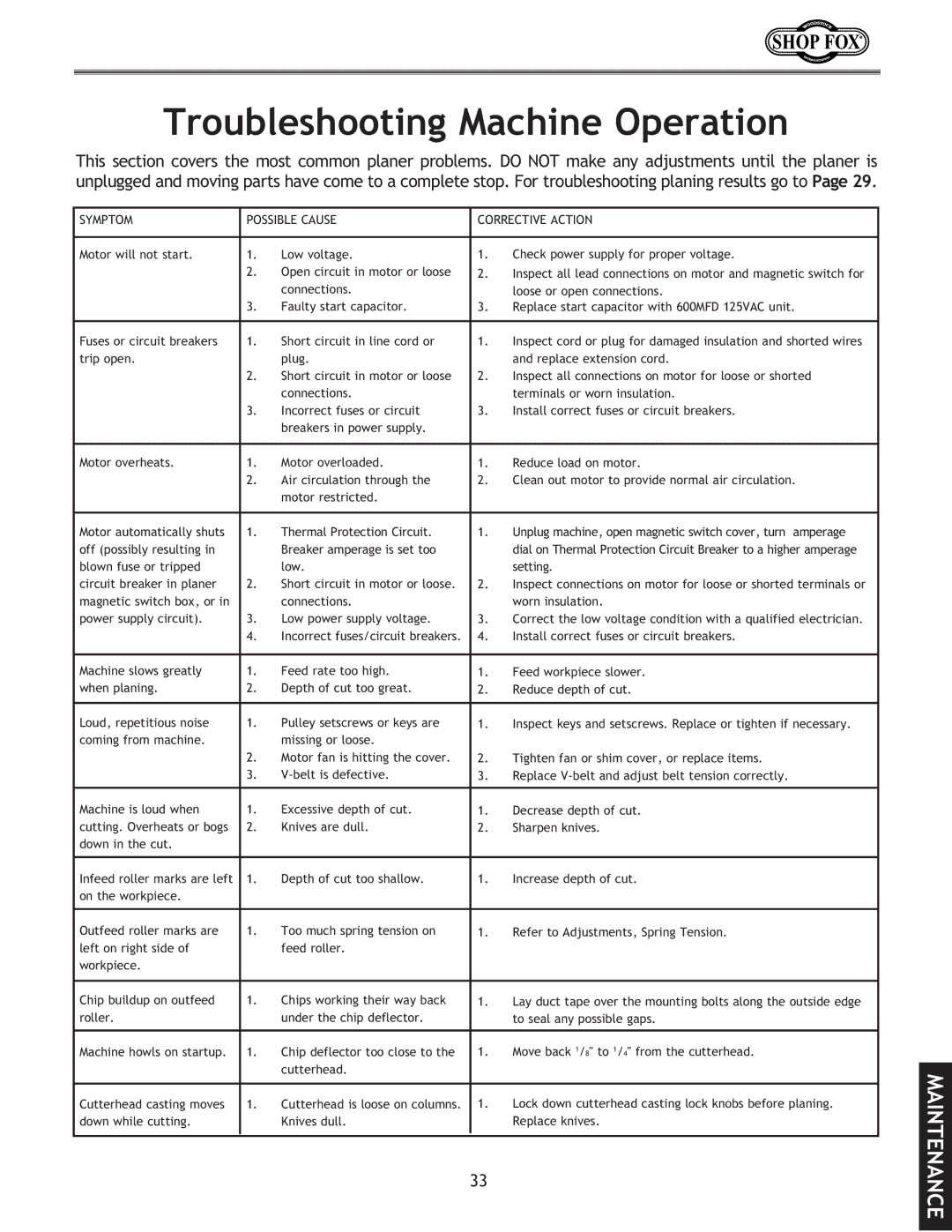
Troubleshooting Machine Operation
This section covers the most common planer problems. DO NOT make any adjustments until the planer is unplugged and moving parts have come to a complete stop. For troubleshooting planing results go to Page 29.
SYMPTOM | POSSIBLE CAUSE | CORRECTIVE ACTION | ||
|
|
|
|
|
Motor will not start. | 1. | Low voltage. | 1. | Check power supply for proper voltage. |
| 2. | Open circuit in motor or loose | 2. | Inspect all lead connections on motor and magnetic switch for |
|
| connections. |
| loose or open connections. |
| 3. | Faulty start capacitor. | 3. | Replace start capacitor with 600MFD 125VAC unit. |
|
|
|
|
|
Fuses or circuit breakers | 1. | Short circuit in line cord or | 1. | Inspect cord or plug for damaged insulation and shorted wires |
trip open. |
| plug. |
| and replace extension cord. |
| 2. | Short circuit in motor or loose | 2. | Inspect all connections on motor for loose or shorted |
|
| connections. |
| terminals or worn insulation. |
| 3. | Incorrect fuses or circuit | 3. | Install correct fuses or circuit breakers. |
|
| breakers in power supply. |
|
|
|
|
|
|
|
Motor overheats. | 1. | Motor overloaded. | 1. | Reduce load on motor. |
| 2. | Air circulation through the | 2. | Clean out motor to provide normal air circulation. |
|
| motor restricted. |
|
|
|
|
|
|
|
Motor automatically shuts | 1. | Thermal Protection Circuit. | 1. | Unplug machine, open magnetic switch cover, turn amperage |
off (possibly resulting in |
| Breaker amperage is set too |
| dial on Thermal Protection Circuit Breaker to a higher amperage |
blown fuse or tripped |
| low. |
| setting. |
circuit breaker in planer | 2. | Short circuit in motor or loose. | 2. | Inspect connections on motor for loose or shorted terminals or |
magnetic switch box, or in |
| connections. |
| worn insulation. |
power supply circuit). | 3. | Low power supply voltage. | 3. | Correct the low voltage condition with a qualified electrician. |
| 4. | Incorrect fuses/circuit breakers. | 4. | Install correct fuses or circuit breakers. |
|
|
|
|
|
Machine slows greatly | 1. | Feed rate too high. | 1. | Feed workpiece slower. |
when planing. | 2. | Depth of cut too great. | 2. | Reduce depth of cut. |
|
|
|
|
|
Loud, repetitious noise | 1. | Pulley setscrews or keys are | 1. | Inspect keys and setscrews. Replace or tighten if necessary. |
coming from machine. |
| missing or loose. |
|
|
| 2. | Motor fan is hitting the cover. | 2. | Tighten fan or shim cover, or replace items. |
| 3. | 3. | Replace | |
|
|
|
|
|
Machine is loud when | 1. | Excessive depth of cut. | 1. | Decrease depth of cut. |
cutting. Overheats or bogs | 2. | Knives are dull. | 2. | Sharpen knives. |
down in the cut. |
|
|
|
|
|
|
|
|
|
Infeed roller marks are left | 1. | Depth of cut too shallow. | 1. | Increase depth of cut. |
on the workpiece. |
|
|
|
|
|
|
|
|
|
Outfeed roller marks are | 1. | Too much spring tension on | 1. | Refer to Adjustments, Spring Tension. |
left on right side of |
| feed roller. |
|
|
workpiece. |
|
|
|
|
|
|
|
|
|
Chip buildup on outfeed | 1. | Chips working their way back | 1. | Lay duct tape over the mounting bolts along the outside edge |
roller. |
| under the chip deflector. |
| to seal any possible gaps. |
|
|
|
|
|
Machine howls on startup. | 1. | Chip deflector too close to the | 1. | Move back 1/8" to 1/4" from the cutterhead. |
|
| cutterhead. |
|
|
|
|
|
|
|
Cutterhead casting moves | 1. | Cutterhead is loose on columns. | 1. | Lock down cutterhead casting lock knobs before planing. |
down while cutting. |
| Knives dull. |
| Replace knives. |
|
|
|
|
|
33
MAINTENANCE
